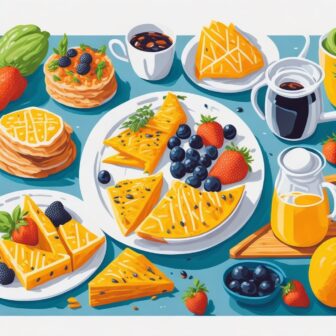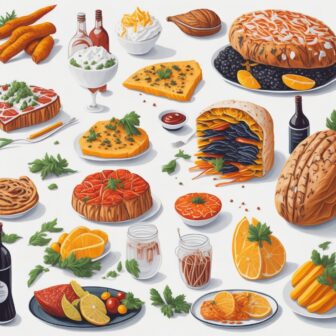15 Facts About German Food
Maybe the most important among the Facts About German Food is that most Germans like to cook. The majority of Germans like to stand at the stove and enjoy cooking. This enthusiasm runs through all age groups. People in single households like to cook just as much as in families. The desire to cook is particularly pronounced among young adults and city dwellers. Above all, cooking has something to do with socializing.
The Favorite Food in Germany is Pasta
The majority of Germans prefer to eat spaghetti, spaetzle and other pasta. When it comes to preferences in Germany, pasta is followed by potato and vegetable dishes, followed by fish dishes, salad, pizza and schnitzel.
In Germany, unfortunately, twelve percent of Germans have to avoid certain foods that contain lactose, fructose or gluten due to intolerances and allergies. Women are affected more often than men.
Pretzels originate in Germany
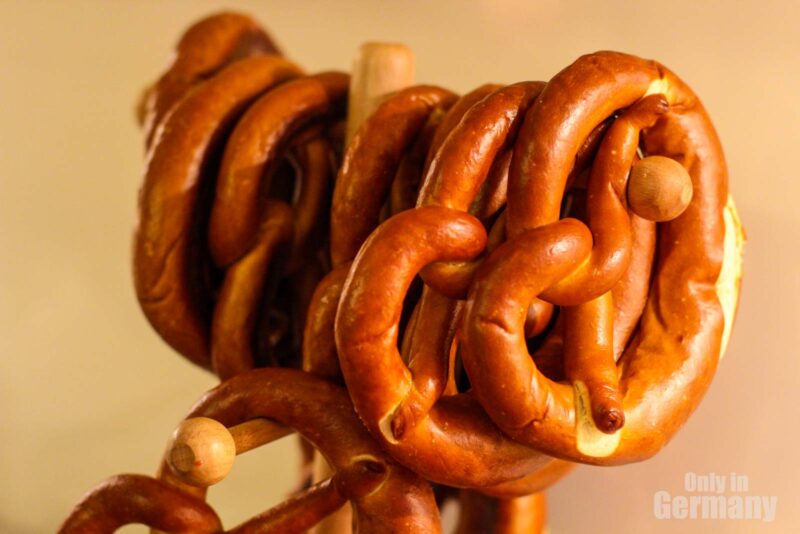
There is the Swabian Brezget, which has a big belly and thin, lowered arms. With the Bavarian Brezn, both are equally stout. In addition, it has no slit in the stomach area.
A hand-made pretzel tastes different than one from the machine, namely “rescher” (Swabian for crispy). It’s the dough. For the machine (output several thousand pieces per hour) it has to be thicker and stronger, otherwise it will tear.
One of the many legends of its origin dates back to the Middle Ages. According to this, a baker from Bad Urach who was sentenced to death was said to have been pardoned because, as required, he invented a pastry through which “the sun shines three times”.
The word Bretzel (pretzel) is derived from the Latin bracchium (arm).
Experts say that you can tell from the position of the knot whether a right-handed or left-handed person tied a pretzel.
Maultaschen: The German dumplings
When we look at the history of the Maultaschen, the most popular theory dates back to the 17th century. According to legend, a monk at Maulbronn Monastery was given a large piece of meat during lent before Easter. To eat it secretly, he chopped the meat into small pieces, mixed it with vegetables and hid it in the pasta dough. Today Maultaschen are enjoyed throughout Germany and in many other countries around the world.
Fun fact
Maultaschen have even made it into space: when the German astronaut Alexander Gerst was on the ISS space station in 2018, Maultaschen were served
Spätzle
Making spaetzle is easy: flour, eggs, water and salt, that’s all you need. Compared to Italian pasta, spaetzle dough is moister and softer, so it cannot be rolled out. Instead, you push, scrape, or cut it directly into the water. The cooked spaetzle are then fried in butter, baked with cheese or served as a side dish.
It is said that spaetzle used to be shaped into small pieces of dough by hand or with a spoon. The result resembled a “Spatz (sparrow)”, which is why they were also called “Spatzen (sparrows)”. Another theory is that the word “Spätzle” comes from the Italian word “spezzato” which means “little pieces”.
Fun fact
Since 2012, only the Swabians themselves have been allowed to scrape real spaetzle: The European Commission has protected the Swabian Spaetzle and Knöpfle pasta types. They may now bear the EU-wide seal of quality for “protected geographical indications” if they were manufactured in Swabia.
Why does the Oktoberfest take place in September?
The first Oktoberfest began on October 17th - today the Oktoberfest starts exactly one month earlier and usually ends on one of the first days of October.
The reason for this postponement is the legendary bad weather in Munich, which can sometimes bring a snowstorm in October.
“There are many rumors, some of them bad, about the climate in Munich,” says a Munich travel guide from 1863. And Munich’s director of the observatory, Johann von Lamont (1805–1879), even calculated it very precisely: “We have perfectly happy days in Munich only 17 a year, completely cloudy 127 and a mixed 221.”
From experience, people knew that the summer in Munich could still bring a number of brighter days in September, and so the proposal was made as early as 1828 to hold the Oktoberfest on the 3rd Sunday in September brought forward, which the city council rejected.
The reason: the area around the Wiesn was still an agricultural area where “the Grumet will not be brought in before the end of September”.
So you had to wait for the harvest before the Oktoberfest suppliers and visitors trampled down the fields. As a punishment, it poured from all clouds that year that “even the royal pavilion no longer offered any protection”.
It got even worse in 1829, because four days after the opening, the first snowstorm swept over Munich, and “all the stalls were closed, the Theresienwiese deserted,” as the city chronicler noted. Only when the fields around the Wiesn had been converted into building land was it possible to move the start of the Oktoberfest to September in 1872.
It was not until 1904 that the city council finally decided on today’s rule, according to which the main Oktoberfest Sunday should be between September 28th and October 4th.
Must be meat
Just three percent of Germans eat vegetarian food and consistently avoid meat and sausages. For women it is six percent. For men, on the other hand, it’s only one percent. The majority of men in Germany don’t even think about becoming vegetarian.
Many foods in Germany are named after locations
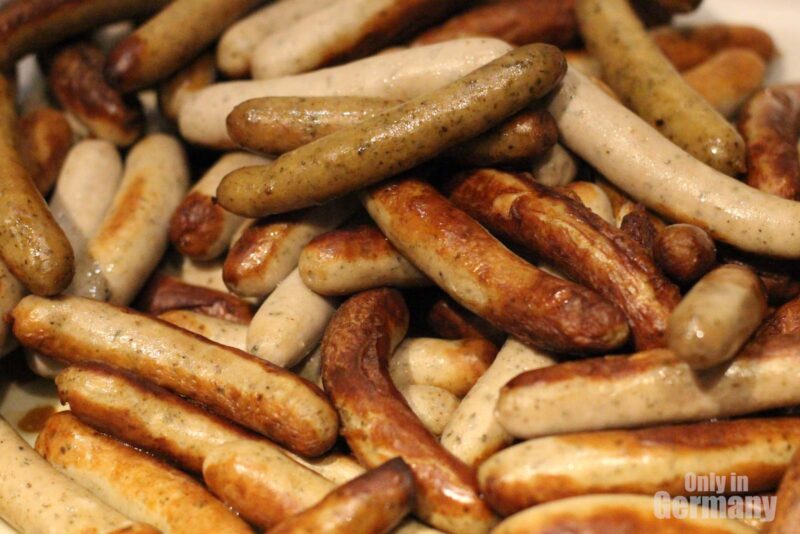
There is no ham in a hamburger. That’s because Hamburg served as the inspiration for its name. And it’s not the only food that has his the origin of its name in a real place. The Frankfurter Kranz (cake) and Frankfurter hot dogs come from Frankfurt, Berliner Weiße (beer) and Berliner Luft (desserts cream) from from Berlin, Battenberg cake from Battenberg and Nürnberger Lebkuchen comes from Nürnberg.
Women in Germany eat healthier
The greater nutritional awareness of women is already evident from the fact that the majority of women in Germany eat fruit and vegetables every day. In Germany, more women than men also buy light products with fewer calories, sugar and fat. Overall, Germans manage to mostly or almost always eat healthily in everyday life.
That’s what Germany eats for breakfast
Half of Germany usually drinks coffee in the morning – sausage and sweet spreads end up on bread and rolls about the same amount.
For the Germans, mainly coffee, bread and cold cuts. Coffee is the most common item on the breakfast table. Younger people generally prefer tea and older people prefer coffee.
Bread products, along with toppings and spreads, also end up on the plate: For every third German cheese is part of breakfast, rolls, butter and bread are also important, followed by sausage and sweet spreads.
And something else is striking: While rolls and bread are about the same in the West, the former are much more popular in the East.
Shopping around the corner
The majority of consumers don’t have it far to the nearest supermarket. Half of them can walk to it and the other half can reach it in no more than 15 minutes by bus, bicycle or car. This applies to both urban and rural regions. More than half of Germans buy their groceries in the supermarket, about a third each in the discounter and in the grocery store.
Why do Germans desire Turkish cuisine
It has been more than 55 years since Turks stated to live in Germany. It is now the fourth generation and in this period a lot has changed from the first to the last generation. They are different from the Turkey-Turks in many ways, how they live, think, talk, dress or decide. Even the language has changed incredibly.
But there is something that has never changed: the food! The Turks cultivated their eating habits to such an extent that German food culture changed.
There are three important reasons for this.
First of all, Turkish cuisine is a part of Mediterranean cuisine and the specialties of this cuisine are primarily healthy.
Second, Turkish cuisine is a product of a multi-ethnic state.
The Ottoman Empire was formed of many peoples from the Balkans, Caucasus, Anatolia, Middle East and North Africa. Together, these peoples brought out a rich cuisine culture that was popular not only at the local level but at the transcontinental level.
Third reason is the fact that the ingredients of Turkish cuisine must be always fresh. And so, these days Germans also enjoy eating the fresh Turkish food specialties.
Organic Food is very trendy in Germany
Germans are looking for food with fewer pollutants, more taste and much healthier. In smaller towns in particular, older consumers still like to go to the butcher, baker or greengrocer. Just a relatively small number of Germans order their groceries online and have them delivered to their homes.
Germans are even willing to pay more per kilogram of meat from more animal-friendly farm.
The Origin of the Schwarzwälder Kirschtorte (Black Forest Cake)
Cherries, cream and chocolate. With a dash of kirsch on biscuit, this combination is known and loved far beyond regional borders. Most people probably associate the Black Forest cake with the Black Forest. However, opinions differ as to whether it really has its origins here in the region. Text, Video, Audio, Recipe.
As the name suggests, the Black Forest cake comes from the Black Forest. One thinks. At second glance, however, there is an unexplained past behind this traditional German cake.
The Black Forest gateau started in the glass. There are only a few documented facts about the tradition of the dessert. The Black Forest gateau does not have its origins as a cake, but as a layered bowl dessert. The fact that a cake was formed from it only started in the 1930s. This was made possible by the introduction of cooling devices. This invention thus paved the way for cream cakes of all kinds, regardless of who was the first to develop the schnapps-cream-cherry combination as a cake
It is interesting that the Black Forest gateau has experienced rapid spread in the large and well-known cafés in German and Austrian cities. As a result, it initially established itself as the most famous German cake. Today, their fame extends far beyond Germany.
Three theories for the further development of the cake
There are different stories about the creation of the cake as such. However, none of them are verified. There are two confectionery families or businesses that claim to have created the first Black Forest gateau.
The best-known version says that the confectioner Josef Keller, who came from Riedlingen, invented a cake in a café in Bad Godesberg near Bonn in 1915, which went down in history as the first Black Forest cake. Keller is said to have later served this creation in his own café in Radolfzell on Lake Constance.
The second story is said to have taken place in Tübingen. Research by a local city archivist revealed that a confectioner named Erwin Hildenbrand is said to have baked the first Black Forest gateau in 1930. However, this assumption is only based on oral stories of third parties.
There is also another theory that the cake comes from Switzerland. There is a “Black Forest cake” that does not contain cherries or kirsch. The name comes from dark soil and chocolate, reminiscent of a black forest. However, it is highly questionable that the creation that is known today as the Black Forest cake came about from this.
So today, due to a lack of evidence, all three stories coexist.
There are uncertainties about the origin of the name.
There is also no agreement on the origin of the name. It is conceivable that the colors black, white and red are reminiscent of Black Forest costumes. In particular, the comparison of the cherries with the well-known Bollenhut is obvious. If you believe the theories that say the cake comes from the Black Forest, the name can be explained by its origin. Another version traces the name back to the Black Forest cherry, which is an essential part of the cake. To date, none of these theories has been proven to be the only true one.
However, there is no one Black Forest cake or one recipe. Every wife, every husband and every confectioner bakes it differently.
Officially, however, there are some rules as to when a cake may be called “Black Forest Gateau”. The “Principles for fine baked goods” state that the cakes must be cherry cream cakes or cherry buttercream cakes in which the added cherries are clearly perceptible in terms of taste.
The Black Forest gateau has been a registered “guaranteed traditional specialty” since 2014. The Federal Agency for Agriculture and Food prescribes the minimum requirements for a “product of this name”. The cherry must be Black Forest cherry. The diameter of the cake (17 cm), the fat content of the cream (30 percent) and the cocoa content of the biscuit base (3 percent) are also specified.
Of course, these regulations do not necessarily apply to private bakers. After all, everyone can bake their own Black Forest cake as they like. Whether based on years of tradition or a recipe from the Internet, the main thing is for it to taste good.
RELATED
Insanely Delicious Traditional German Desserts You’ll Want to Try
Too good for the bin
The elderly are true masters of leftovers: Germans over 60 age group never throw away food. Not the same can be said about young people. Lot’s of their food ends in the bin.
Coffee, beer or water? This is the most popular drink in Germany
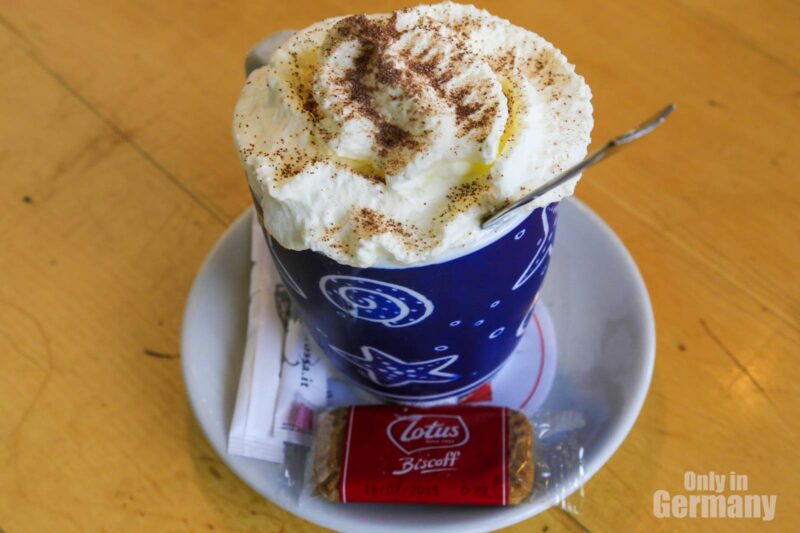
For many Germans, coffee is part of the start of the day, while a beer is then to end of the day. Germans prefer to sip coffee variations with milk. The most popular variant is the cappuccino, followed by the latte macchiato in second place and the classic espresso in third place.
Carbonated water is the next on the list.
When it came to cocktails, the Aperol Spritz remainsthe undisputed number one.

